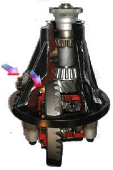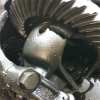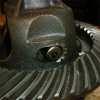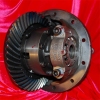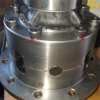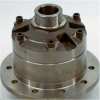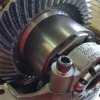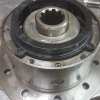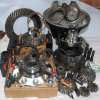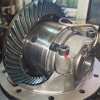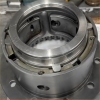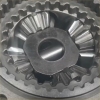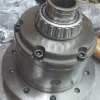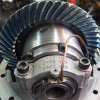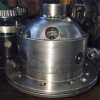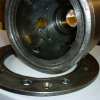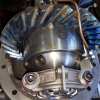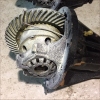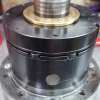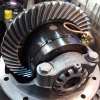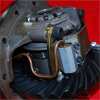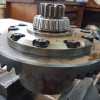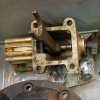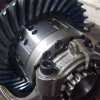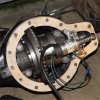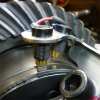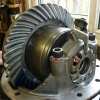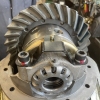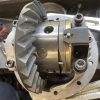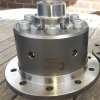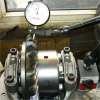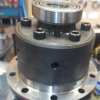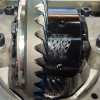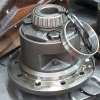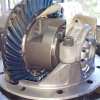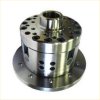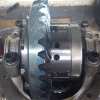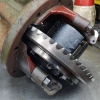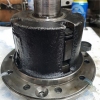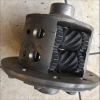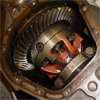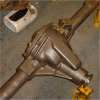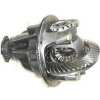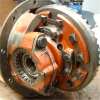Let's start at the beginning.
Standard Land Rover 'Long Nose' Differentials are often known as '2 Pin' units. Fitted pretty much all Land Rovers with Long Nose differentials, it's a hopelessly spectacularly very weak unit, which can't be made better as it is. Its design flaws stop any sensible upgrading and for something better you have to look elsewhere. There are a raft of areas that fail, most common is the single pin that holds the planet gears in the centre tube being the highest culprit, and on this point the '2 pin' name is hugely misleading - it has just ONE cross pin holding a gearset at each end. The centre casing itself is prone to heavy wear and can crack, the CWP bolts shear and come undone, oh plus the planet gears can jam and weld themselves onto the insides, for starters, or just break up. lol. All in all, for anything other than a road going 4x4, they are simply a waste of time. Upgrading from 10 Spline to 24 Spline units is pointless, as the single '2 Pin' issue and all other areas remain the same - and hence the Diff will still break. It's a good idea before you go further to understand simply 'How exactly a Differential works' - watch the video - Old, but still the easiest and clearest explanation we've ever seen. We do not do ANY work on these units, even on request - Do NOT waste your money rebuilding, its just pointless. If its worn out or broken either buy another decent 2nd hand one - or put the money saved towards something better. The End. The Question now maybe is what to go for ?. ....... The 'Answer' may just be below when the mist clears !**** We are CLOSED Until 6th January 2026 for the Christmas Break **** Questions or Queries - E-Mail : megasquirt.v8@gmail.com And we will reply when we Re-Open in the New Year
 Helpful 'Reference Guide' for all the Types, Variations & Options you can have as Differentials in Land Rovers
Helpful 'Reference Guide' for all the Types, Variations & Options you can have as Differentials in Land Rovers
Land Rover Differentials - Technical Overview
For the vast range of Land Rovers there are 2 x Types of Differentials, 'Long Nose' and 'Short Nose'.
With a few exceptions most Series LRs, LR 90s, Discoveries, Defenders, and Range Rover Classics all have 'Long Nose' Differentials. 'Short Nose' units are in Range Rover P38s and LR TD5 110s and 130s which have Short Nose Rears and 'Long Nose' fronts. The other Differentials are 'Salisbury Units' and are easily identified as they have a bolt on Cover on the rear of the axle pan. Long, Short, and Salisbury Differentials are NOT interchangeable. Long Nose Differentials are either 4.7:1 Ratio and 10 Spline Drive (Series LRs), or 3.54:1 Ratio, for pretty much everything else which can be either 10 or 24 Spline Drive.The 'Starting Point' - Land Rovers '2 Pin' Units - The 'Standard' 'Long Nose' Differential
Land Rover '4 Pin' Units
These are still an 'Open Differential', behaving exactly as a 2 pin, but these are stronger. Much much stronger.
'Watch the Video explaining Land Rovers '2 Pin' Differentials vs '4 Pin' Differentials + Forged Cross Shafts' These can be either Land Rovers own 'Heavy Duty' units, which were fitted to Land Rover 90 V8 rear axles, or often are LR 'Special Vehicles' units fitted as a 'HD Upgrade', or very cleverly machined 'Short Nose 4 pin centre re-machined to fit into a 'Long Nose' Casing with a matched Long Nose CW&P set. (and no, not a DIY job !). We have made many of these, and will do to order if centre supplied, we have stopped doing these now as a stock item as 'Short Nose 4 Pin Centres' have become hard to source. Note: Only P38 4.6 Rear Diffs are '4 Pin' all others are a '2 Pin' 'Short Nose'. Other '4 Pin' 'Long Nose' Differentials can be obtained from KAM (now Allmakes) who manufacturer a nice 4 Pin centre, these units can be made / upgraded into a 'Plated LSD'. The Good points are the forged centre cross shaft, which adds a lot of additional strength, Cons are these are not cheap units. Ashcroft Transmissions also do a 4 pin unit, with large 18mm Cross Pins around £100 less than the KAM unit, but doesn't have the KAMs Forged cross shaft.Automatic or 'Auto Lockers'
Automatic Lockers, or 'Auto Lockers' as they are often called, are units that in the simplest sense, try to aid traction via having drive on both wheels as much as possible.
The 2 units that are well known and popular are the 'Detroit Locker' and the 'TrueTrac' Locker. How they work is very very very different. Both these units have been about years, these units predate the now more popular 'Command Lockers', which for many are the best route to have. Auto lockers are a simple fit and pretty much 'fit n forget' unit, other than keeping oil fresh and clean. But, they are and never will be a true 'Command Locker', they lock / unlock when they think its right, ....not when the driver wants it. They have a place in the 4x4 world for sure, but a diminished one from years back. They are not a True 'Command Locker', as we will see further below.'Detroit' Lockers (Eaton)
Often referred to as 'Automatic' Lockers. They work via maximising traction delivering 100% of the torque to both drive wheels.
These are engineered to keep both wheels in a constant drive mode, and have the ability to automatically allow wheel speed differentiation when required. These pre date Command Lockers. One issue with these is after sales Support (or lack of) and spares, the other is when they go wrong its pretty much the end !. Made in both 10 or 24 spline versions, only the 24 spline is current production. Many peeps swear by them, others swear at them. For off road use they often end up locked, taking you where you do not really want to go because they will not open. Although strong they have a limited appeal. We do NOT undertake repair work on these units !. NOTE : Only ever fit in the rear axles do NOT fit in Front axles.Manual or 'Command' Lockers
These are differentials that are normally 'Open' and can be 'Locked' and 'Unlocked' by a switch or lever that is decided by the operator and not the differential itself.
The vast majority of 'Command Lockers' are Air Operated via a on board compressor with a tank of compressed air. The Locker is operated by being switched on, the compressed air thereby locking the differential, switch off the air pressure exits, and the unit(s) unlock. There are some like the KAM 'DIL' Locker, that use electrics via a switch, and even some older units via cable pulls. The ARB compressor is viewed as the best compressor for ALL air activated differentials, as it has a built in safeguard not to overpressure the differentials seals and pistons. Ashlockers and ARBs alike will be damaged if excess of 85 psi is used. Now lets look at what's out there Locker wiseARB - RD03 - 10 Spline only
Probably the Locker that started the Locking Differentials as the 1st on the market !. Back in the '80s ARB launched the RD03, an air operated Locker for Land Rovers (and other makes) for the 10 Spline half shafts. These units are now quite rare, partly due to age and wear and partly due to the mass move to 24 spline.
These suffer from a range of issues. A BIG one is the lack of spares, many parts are NLA. However we now remake many of the NLA parts that fail, even improving on them. However, the biggest issue (with all ARBs) is air leaks. This can be the internal Piston itself, the 2 x air seals, both can be repaired by us. However wear on the Air Journal Flange or End flange, (both NLA) up to now has rung the death bell for these Diffs - both these the RD03s & RD56s). The good news is we stock of these NLA parts made by us, and using far stronger modern High Grade EN Heat Treated steels. The Air Flange Plate on these models also varies with age. Early units have 'O' Rings on the flange itself in machined groves, and the later RD03s have a different Air Flange Plate with a smooth (or it should be !) Flange surface, the 'O' Rings in groves in the Air Rings, both types have differing fitments, plus the Air Rings and Flange units themselves are non interchangeable, we do upgrade Air Flange Plates, Air Rings and 'O' Rings for both types. The Plastic Cage centre (as with the later RD56) is also prone to failure from long term use, which whilst cheap entails a complete 100% strip down to change. But, if you need a 10 spline unit these are great little lockers if in decent condition, often many that come to us have been horribly abused and past any sensible reconditioning, but we do get them from time to time. Video of Internals of a RD03 and RD56ARB - RD 'Prototype' Pre Dating RD03s - 10 Spline only
Just now and again you might come across one of these
There is potentially both 'Good' and 'Bad' news !. These are easily identified by only having FOUR bolts showing on the air end flange side. These predate the RD03s, and are prototypes with no number as such after the 'RD'. These were made for a short time, then cost saving took place. The fabulous STEEL cage was replaced by the cheaper to make plastic one, plus the locking system is more complex and different. Parts are NOT interchageable, so if you find one - they are great units, but if damaged you are most likely looking at a (lovely) but scrap unit. In good condition these are actually stronger than the later production RD03s Video of a ARB 'RD' PrototypeARB - RD56 - 24 Spline only
These are as the RD03 above but with some minor changes.
Be aware that many RD56s parts are NOT interchangeable with RD03s, and RD56s suffer pretty much the same failure issues. End Flanges breaking, CW&P holes cracking and Air Journal Flange wear and Air leaks as above. We regularly repair these units, often using the parts we make to replace damaged parts NLA. The plastic cages are the same as the RD03 and suffer similarly !. However, these are a great 'Bread & Butter' Locker, rarely when they break can they not be repaired. with our end flanges on each side and a new cage and thrusts and maybe pegged as well, these are a really good locker for someone on a budget. The Centre Tube bolts are very weak grades, and the locking clips can drop off and actually blow the differentials up ! (RD03 and RD56s. We upgrade these). Video of Internals of a RD03 and RD56 Warning : Many you may see for sale on eBay etc will be desperate for a big rebuild, so beware, parts prices are not cheap, and some parts are NLAARB - RD128 - 24 Spline only AND RD138 24 spline Only
The current latest ARB offering. Some will say better - We are not so sure !. Video of Internals of a RD128
The 'Centre Tube' now has a 'End Flange Plate' as part of the assembly, the earlier ARB RD03s and RD56s had a 'End Flange Plate', 'Centre Tube', and 'Air End Flange Plate' - 3 Pieces. The RD128 has only 2 pieces, the Centre Tube and End Flange is one unit, and the Air End Flange the 2nd piece. These one piece centre tube assemblies suffer from the Crown Wheel 'Flexing', as it is overloaded by input through pinion and grip from wheels etc), and these shear off. Pegging the Differential does help strengthen these, as it stops the flex which shears the end plate of the tubes. Centre tubes are serious money, plus as they break the broken bits are right in the internal gearset area, so secondary damage is often caused. On the earlier RD03 and RD56 yes the cages can break up, but, they are plastic, as and such most times there is no additional damage as the plastic just gets mashed up. The air pipe air coupler swaps sides and the soft easily damaged copper pipe now ends up going over and close to the Crown Wheel - probably one the daftest ideas we gave ever seen as a replacement model - creating an issue he previous model didn't have ?.... The plastic cage is now replaced by a more conventional all steel unit with bigger massive 20mm pins etc, but, should these fail (which they do) the results can often be catastrophic as everything smashes into itself. We do an upgrade kit for the daft 'Over the Crown Wheel' copper pipe to help protect - it shown in the second picture on the right (and these can be easily fitted as a DIY Upgrade). Issues again are air leaks, internal Piston and external Seals, and the Air Flange Plate wears badly where the seals locate, and then leaks - which like the replacement Centre Tube, the End Air Flange Plate is very expensive. The RD138 is the same offering modified to fit the Short Nose Casing. Oddly we didn't do much with these as they were mainly for Front and Rear axles on Range Rover 'P38s', most of which have died and gone to the LR Scrapyards in the Sky. However we are seeing them more and more, on Challenge Trucks, Cummins conversions and 110 TD5 and later rear axles only (Front is a standard Long Nose so RD128). Due to thus seeing more and more of these for repairs and upgrades we are (Feb 2017) in the middle of a prototyping project to 'Peg' these Short Nose Casings. The thinner Crownwheels used on Short Nose units are weaker than Long Nose Crownwheels, so Pegging will be a huge increase in strength to this unit.ARB - RD127 - 10 Yes 10 Spline
You learn every day, especially with ARBs.
This is a fairly rare unit, and we believe still available new. It looks to all cursory 1st looks as if its a RD128, but the subtle differences on this is the 2 x drive gears are 10 spline. In fact they are SO identical to look at I wrongly identified a pair of these when I saw them up for sale, questioning the seller that they were 24 spline, he was adamant they were 10. I was wrong !.. Ooops my Bad ! However, although these are 10 spline it is highly likely that these units will suffer the same issues as the RD128. - Namely 'Pipe Damage' and 'Centre Tube shearing' as these are core wise the same units as RD128 with 10 spline drive gears. However being 10 spline the shafts (even if you can locate the HD GKN Units) will be weaker than a HD 24 spline shaft, so its flip a coin as to the 'top' weak break point. Our advice is to peg these and that solves the centre tube issue. As on the RD128 the air pipe air coupler ring swaps sides and the soft easily damaged copper pipe now ends up going over and close to the Crown Wheel - probably the daftest idea ever. We do have a fix to sort this - see our Clamp Kit solution - bottom picture on LHS shows fitted. Issues again are common ARB issues - air leaks, Internal Piston and External Seals, and the Air Flange Plate wears badly where the seals locate, and then leaks - which like the replacement Centre the End Air Flange Plate is a very expensive replacement. Gears cannot be bought separately only as a set of 6, so you can't financially convert this to a RD128 24 spline for sensible £sAshcroft Transmissions - Ashlocker - 24 Spline only
Currently, and has been for some time our No 1 favorite. Video of Internals of an Ashlocker
Yes we are approved Ashcroft dealers, but we chose Ashcrofts as our No 1 choice because of service back up and fairness. EVERY single part for an Ashlocker is available and from experience in 24 hours to us should we need a part we don't have. The BIG difference is in the way the air system works. On an ARB the seals rotate with the wheels, irrespective as to if locked or unlocked. The Ashlockers Seal / Piston does NOT rotate, and hence doesn't wear it moves ONLY to lock and then back when unlocking. Pretty much trouble free. Cons ? - Well, You have to destroy a bearing to get the air ring off, more annoying than anything else, and you have to be super careful undoing the very small countersunk Allen bolts as they can round off it a second or less !. Cages are steel but can wear in heavy use / abuse, and the air ring can damage seals should you get foreign bodies and swarf in the oil which can embed in the bronze air ring and make the seal leak. Very tricky to dismantle the long 3mm cotter pins. But keep the oil clean and they seem to just go and go and can take a LOT of abuse....McNamara Locker - 24 Spline only
Rare and highly desirable !.
Made yonks back using very high grade metals even by todays standards. Air operated by an external piston and a sliding fork assembly. Parts next to non existent, but never seen a broken one, just normally needing bearings and a clean up. If you find one it will not be cheap - in any condition, prob the holy grail of lockers. Super Super strong and were near 2 x an ARB price when new - hence rarity !. The modern ones are not a patch on the originals !KAM 'Air' Operated - Long Shaft' Locker 24 Spline only
The 1st ever KAM locker. HUGELY strong everything well over engineered !!, so they do last Video of a KAM 'Air' Locker .
AIR yes AIR operated !. You'll be lucky to ever see one of these due to age and low production. Quite rare and quite loved by those who have them. Hugely reliable as a really simple design, with no small delicate parts !Fitted via a hole cut in the top of the Axle tube on the long shaft side, and a shaped metal mounting plate welded on. A long shaft with ultra long splines has a long locking shaft over it which engages with the long splines and a locking dog on the diff flange.
A 'actuator' unit bolted to the top of the mounting plate to a pump - often these have been replaced by ARB pumps as just pipework. Super strong one piece solid forged cross shaft to support the 4 x sun gears. Much stronger than you might think - I know of a few out there still in use - and competition use at that ! Cons ? - Spares. The long shaft long splines can twist esp + current trend of big tyres, ( say over 31s) but you could now get 300M shafts made with these long splines if you really wanted to ! We have some spares but not many for these. A bit of history really in the Locker world - and not as antique as you might think - ahead of its time !! Was replaced by the later KAM Locker with weld on mounting plate for cover and the Electric Solenoid Operation vs Air.KAM 'Quill Tube' Locker + LSD Packs - 24 Spline only
Sadly - No longer in production. Video of Internals of a KAM 'Quill Tube' Locker
Electrically operated by switch and huge powerful solenoid via a 'locking dog' which engages into the side of the end flange. Also had a one piece solid forged cross shaft to support the 4 x sun gears. Unit itself is impressively, massively strong !. Cons ? - Spares. We prob have the largest world stock on these, so ring. Lovely unit, downside was often seen as having the need to cut the diff pan off the axle tube and weld the mounting ring on (which we have stock of) but once done the locker when fitted was ultra strong and reliable, shame it was discontinued IMHOKAM (aka Allmakes) 'DIL' ('Drop In Locker') - 24 Spline only
When Allmakes bought KAM they discontinued the old style locker above - it was expensive and complex to build up, and decided to go with the current DIL (Drop in Locker).
Named as such as it fits straight in without the need to cut axles and weld rings on etc. Much is made of the fact it doesn't need a compressor (true) and is thus easier to fit (also prob true). But pricing wise its weird. You can buy 2 x Ashlockers AND a ARB Compressor for less than 2 x DILs, and the delicate springs on the brushes holder and the brushes themselves have proved to be more than a little delicate. We have had 2 x for repairs with the same issues on both. Dirty oil is a killer on these. Now no longer made - replaced by Terrafirma TF450 E-Locker (see below)Terrafirma (aka Ex Kam / Allmakes) 'TF450 E-Locker' - 24 Spline only
The 2 or 3 'Versions' of the DIL are now no longer made, the TF450 launched in 2022 is the new offering from Terrafirma
Its an E-Locker, so is basically a locker and a long wiring cable plus switch, easier and quicker to install than say an Ashlocker, price wise little in then for full installs. As with the previous DILs - Dirty oil is a killer on these. Here is a video to see this in more detail : Video of a TF450 E- Locker>
LSDs (limited Slip Differentials) + ATBs (Quaife Auto Torque Biasing) + Gleason / Torsen (Cross-Axis Style Helical Geared Units) AATB (Ashcroft)
'ATB' (Automatic Torque Biasing - Quaife Units) and AATB (Ashcroft Units) vs. 'LSD' (limited Slip Differential). What's the difference ?. Ok, Both aim to improve grip and handling by way of limiting the amount of wheel slip through the driven wheels, but both do it very differently.
'ATBs/ AATBs' have gears inside, 'LSDs' has plates. But, how they work and behave also makes them different. ATBs are good when the 4x4 has good grip on both wheels, but, it's important to understand an ATBs / AATBs BIASES torque to one wheel over another, but cannot completely re-direct it to one wheel in the event of say a half shaft breaking .... It will never fully "lock". ATB / AATBs, being all gears are very low maintenance LSDs are plate-type differentials. These units are more complicated and more tuneable than a ATB/AATBs. 'Ramp Angles' and 'Pre-Loads', can be fine tuned - which changes behaviour. They lock/ unlock faster than an ATBs, but more aggressively. Friction plates wear, and may even need replacing over time. Unlike a ATB even with a broken half shaft a LSD Plated unit WILL provide drive, albeit with ALL power going through the one unbroken driveshaft. So what's available ?Quaife 'LSD' 10 Spline or 24 Spline 'ATB'
Quality Quality Quality.
The finest machining we have ever seen and everything is just .......quality...with a Capital 'Q'. Gear driven LSD (ATB) 10 or 24 spline available, er...and brace yourself on prices. Quality is never cheap. Quaife is for those who want the very best LSD / ATB. Period.Ashcroft AATB - 24 Spline only
Basically a Quaife copy, even so copy or not its stunningly stunningly ! good value for money.
Gear driven and mighty strong and price is really amazing. No its not a Quaife, but your not paying Quaife money. If you want a LSD and if money is no object (or it has to be 10 spine) then 1st Quaife, then 2nd Ashcroft AATB then 3rd KAM Plated LSD'Tru Trac' Lockers
Truetrac are a gear driven type torque bias design.
Operating like an open differential in high-traction conditions (i.e. Road), but off road the helical side gears prevent one side from spinning while the other side remains stationary. If traction is very poor helical worm gears are pushed away from the larger helical gears and pushed into the carrier. The additional resistance on the side with less traction diverts torque to the other side of the axle. Truetracs are made in 2 'strengths' one for fronts and another heavier clamping unit for rears, its a very bad idea to fit a rear in the front unless you are a practising bodybuilder !. Similarly although strong when they fail they go big time !KAM LSD - 24 Spline only
The KAM unit is a 'Plated' Type LSD with the KAM Lockers Forged Cross shaft (making it strong) for the centre, and it is basically the 4 Pin unit with some internals changed to make it a LSD.
A VERY strong unit, but, due to the plate design the preload often will drop. What is good is that you can set preloads for differing amounts front and rear, but they will need constant resetting, which requires the diff to be removed to screw in the preload screws to regain the correct clamping. Vastly cheaper than the Quaife Unit - which is a LSD with gears so the forces of clamp remain come what may, but more than the Ashcroft ATB a Quaife copy. The plated design is 'Old School' some prefer the flexibility over geared LSD some prefer the fit and forgetness of the geared LSD. So, if you want a LSD or ATB ? 1st, if Money No object the beautiful Quaife, 2nd the stunning value (cheaper than the KAM LSD) Geared ATB unit, and then 3rd the 'Plated' KAM.Land Rover Factory 1960s LSD plated 10 Spline
You won't see many of these !.
In original form they will be in an Imperial Casing with a filler plug, and in factory 4.7:1 Ratio Produced around the 60s this was a serious HD LSD unit made for the Land Rover factory - and was a 'Factory' HD Upgrade. Most of these were for military use, a few made it into civilians Series LRs as expensive HD Upgrades to rear axles. Circa 1960s these Factory 10 spline LSD differentials were built when engineers were in charge and ran production not £ scrimpers as nowadays. These ( if you can find a decent one as they are old ) are highly valued buy anyone who has them, and can be tricky to get them to part with them !. They are 'Old School Quality' with a huge capital 'Q'Gleason or Torsen 'T2' LSD 24 Spline
This is a recent addition to the A-Z page - mainly as I knew about them, but they are ultrarare so not often seen.
Then in Oct 2017 I bought a Brand new unused one, so time to update the page !. In the late 40s, and early 50's a Mr Gleason designed the 1st of Cross-Axis Style Helical Geared Differentials which is a LSD but completely different in design and operation to any of the others on the market - now or then. These proved to be very expensive to make, and still are, but hugely strong, it was rumored Gleason sold to recoup huge investments he had made into development. The 'GD' was sold, 'Design'and 'Rights' to a very similar named company who then re branded it, deciding to call it a 'TORSEN' Differential - (Note the company was not called Torsen at this time) the name 'Tor''Sen' being short name for 'Torque' & 'Sensitive'. The GD / Torsen is a LSD but completel;y different in how it works and the speed it works vs a 'ATB' 'LSD' or a 'No Slip'. These 'Torsen' units were also rebranded as 'Zexels' and other names to, but the early GD units were a evolvment from the even earlier Buick 'Mitre Differentials'. The key about these units is that apart from being seriously clever, hugely bloody strong, and seriously super expensive, they are - by design - the fastest operating Unit / LSD ever to be made !.Here's a video explaining how these amazing units work
Salisbury Differentials
The Salisbury Differential was developed at the behest of the British MOD, The existing Differential proving too weak (10 spline 2 pin).
It was based on the Dana 60, as with all thing LR they did it on the cheap so it has its flaws. Axle tubes can snap where they join the diff housing, and like many USA Differentials, the diff is part of the casing itself. Working on them is tricky. Casing needs a 'spreader' to stretch casing mouth remove the diff. Not spread enough diff doesn't come out, spread too much, casing wrecked. These Diffs are strong, and they can build up immense wear and still work, but the parts costs will frighten a dare devil. Loved by some loathed by most !. Run standard 24 spline LR shafts, can be upgraded if you pour money into them. Variations from 1966 early 2002 - Both Leaf sprung narrow axles, and Coil Sprung wider versions. Early are drum brakes later are disc, Replaced by the P38 design ' Short Nose unit. Which is in no way anywhere near the strength of these !'Short Nose' / P38 Type Differentials
The 'P38' Differential (often referred to as 'Short Nose' Differentials), replaced the Salisbury for the MODs 'Project Wolf', as the Salisbury was proving troublesome and weak.
Like the Long Nose Differentials this is again a 'removable' unit, called short nose due to the shorter Pinion and overall length Video of the differences between a 'Short Nose' and 'Long Nose' Differentials It was introduced 1995 with the advent of the P38 Range Rover (1995 thru 2002) hence the name. It was used in both front and rear. The front ring and pinion set was originally a reverse rotation design, a first for Land Rover, which was sadly discontinued and superseded by the regular rotation rear gear set. This differential was also used starting in 2002 as the rear differential on Defender 110 & 130s. Ratio on all is 3.54:1 and the Crownwheel is a weaker design than the Long Nose unit. Until recently we didn't offer a 'Pegging' Option on these - now, with a redesign and another Jig made we can !. This is a really good option on these units as the Crown Wheel is very vunerable as it is much thinner for some odd reason than any of the other Land Rover Differentials !. . Options to upgrade are expensive and limited. It is NOT interchangeable with Long Nose Casings, and it significantly more expensive to rebuild. All P38s have '2 Pin' Centres, with the sole exception of the 4.6V8 which has a '4 Pin' ONLY in the rear.Land Rover 'ENV' Differentials
ENV differentials are a real rare odd ball... and more a collectors unit than anything else now.
They were a version of an Eaton differential, ....that's what the E stands for !. These were used briefly as a heavy duty option in the early 1960’s. The most notable application was the Forestry Rovers. The ENV was a stop gap application while the Salisbury diff was under development. Not considered for anything other than the few LRs they are fitted to !. Shame - wpuld have been an amazing differential for standard Land Rover Axles - but wasn't to be due to cost .
